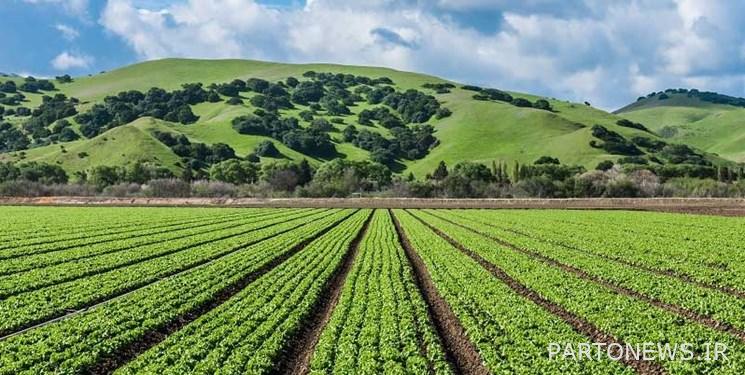500% growth in agricultural production / import of daily energy in the Pahlavi period despite millions of hectares of fertile land

According to the economic correspondent of Fars News Agency, Iranian agriculture has grown significantly during the 43 years after the Islamic Revolution and has been able to significantly improve the production, self-reliance, per capita consumption and value added of this sector by using its capacities.
Before the revolution, Iran also depended on imports to provide daily power, people remember that the shop windows were full of foreign milk and cheese, it was a traditional ranch, technological factories were not enough to produce cheese and butter and dairy products; The total purchase of wheat from agriculture reached 500,000 tons, and we depended on imports to supply this very basic product, and we did not have a good situation in other products.
* 500% growth in agricultural production
However, despite the traditional structure, deprivation and lack of development of rural areas remaining from the previous period, as well as the occurrence of intermittent floods and climate change, which cast its ominous shadow in all parts in the form of global warming, wind, flood and flood. است ، ﺗﻮﻟﻴﺪ ﺗﻮﻟﻴﺪات ﻛﺸﺎ ﻛﺸﺎ Sports between the years 1356 to 1400 from 26 ﺗﻦ ﺗﻦ ﺑﻪود 133% which has grown by 500%, ie the production has increased 5 times.
* Doubling the share of the agricultural sector in GDP compared to before the revolution
The growth of the agricultural sector has not only increased the sector’s production, but also its share in the country’s GDP has almost doubled in the last 43 years. Last week, the Minister of Jihad for Agriculture زی ﺑﺨﺶ ﻛﺸﺎ Sports in ﺗﻮﻟﻴﺪ ﻧﺎﺧﺎﻟﺺ داL (GDP) declared 11 percent, which was 5.8 percent before the victory of the Islamic Revolution.
* More than 100% per capita growth in agricultural production
Meanwhile, the country’s population grew by 140 percent from ﺣﺪود It has increased by 35% from 84%.
According to the data of the Ministry of Jihad for Agriculture, زرا،ی, ﺑﺎﻏﺒﺎنی, دام و ور و آﺑﺰﻳﺎن ﺑﻮده اﺳﺖ. Weight with 290 kg from 102 kg to 296 kg, weight زراWith 86 valleys from 557 kg to 1035 kg, with 1300 valleys from 1 kg to 14 kg and with livestock and 94 with 94 valleys from 95 kg to 184 kg.
* Growth of self-reliance on basic products / self-sufficiency in wheat and sugar production
After the Islamic Revolution, the trend of increasing production in some basic products was also appropriate and has led to the fact that دا• Self-sufficiency and self-sufficiency in products such as chicken, dairy eggs, especially cheese and a significant improvement in self-reliance in other products; Iran also became fully self-sufficient in wheat production after the Islamic Revolution But last year we became importers due to drought and mismanagement in determining the guaranteed purchase price.
Sugar production has reached the threshold of self-sufficiency in the country, in recent years we imported one million tons of sugar annually.
* 10 times growth in agricultural exports
Much of the progress of the agricultural sector has been due to the use of technology, agricultural research and the use of knowledge-based companies, which, with a value of ﺗﻮﻟﻴﺪ ﺗﻮﻟﻴﺪ ﺣﺪ ﺣﺪ ﺳﻄﺢ, ارزشوده ۹اﻧﻪ ﻛﺸﺎ زیورزی ﺑﺎ 239 درﺻﺪ رﺷﺪ از 33 ﻣﻴﻠﻴﻮن رﻳﺎل ﺑﻪ 111 ﻣﻴﻠﻴﻮن رﻳﺎل اﻓﺰاﻳﺶ ﻳﺎﻓﺘﻪ و ﺻـﺎدرد ﺳﺮاﻧﻪ Agricultural Products from ﺣﺪود 13 hours in 1977 has reached 71; In other words, ﺻﺎdrat زیorzi ﺑﺎ ode has more than 10 times increased from ﻫﺎ و و ﻗﺎﺑﺘ ﻗﺎﺑﺘ و و و and has reached ۵ 5504 از from 443..
* Horticultural products The success of agricultural development after the revolution
Among agricultural products, the horticultural sector has the popularity of products and has played an important role in domestic supply and export growth from 1977 to 1397.ات About 550 dirhams from 3.5 percent to 25 percent, agricultural production grew by about 320 percent from 20 million tons to 84 million tons, livestock and poultry products grew by 330 percent from 3.5 million tons to 15 million tons. Million tons and fishery and aquaculture production with a growth of 2100 percent from 50,000 tons to more than 1.1 million tons.
One of the initiatives in growing fishery production is the production and breeding of fish in cages, which is implemented for the first time in the country. Production is done in cages installed in seawater, and with this method, tens of thousands of tons of fish have been produced so far.
* Improving productivity and developing the infrastructure of the water sector in the production of agricultural products
Due to limited resources, especially water resources, which indicate a decrease of more than 70% per capita renewable water in the last half century, the growth of the agricultural sector in the last 43 years should be largely due to management measures to improve productivity, especially agricultural water productivity. He knew that now it has reached more than 42% and 1500 grams of product is produced per cubic meter of water.
Development of infrastructure, use of new knowledge and technology and appropriate investment in this field can be considered as reasons for growth, as despite the reduction of rainfall and water resources, a set of measures has led to significant growth in agricultural production.
New irrigation systems are supported as one of the infrastructures to increase water productivity in agriculture, and therefore the land under the systems has increased from about 37,000 hectares in 1977 to about 2.5 million hectares; Underground drainage has been done for the first time in an area of 390,000 hectares in the country after the Islamic Revolution.
In a forward-looking view and in order to continue the growth of production in the agricultural sector, especially relying on productive methods, several large agricultural infrastructure projects in the field of development of irrigation and drainage networks and equipment for land modernization in about one million hectares of land It is unprecedented in the history of agriculture and with their completion, production capacity will be significantly increased through productivity and employment in the agricultural sector.
* Increase in wheat production despite a slight increase in area under cultivation
In the post-Islamic Revolution, wheat production as a strategyMost Agricultural product has more than tripled and increased from 4 million tons in 1977 to about 13.5 million tons in 1397, while the area under cultivation of this product has increased by only one million hectares during this period, after which production Wheat decreased in 1998 and 1999, mainly due to drought and the lack of a proper guaranteed purchase plan, but this shows that very good capacities have been created to produce this strategic product in the country.
As a result of increasing sugarcane production from 680,000 tons to more than 7.5 million tons and increasing sugar beet production from 4 million tons to more than 8 million tons, sugar and sugar production from 630,000 tons to more than 2 million tons and The country is on the verge of self-reliance.
With the development of lubrication industries and cultivation technologies, the production of oilseeds has increased by more than 2100% since 1977.
By providing the required industrial infrastructure and opportunities for investment, employment and business, chicken meat production has also grown by 1330 percent, from 163,000 tons to more than 2.3 million tons, and egg production by 320 percent growth. It has reached more than one million tons.
* Increase گلخاFrom 500 hectares before the revolution to 22,000 hectares in the post-revolutionary period
Greenhouses, as one of the basic facilities for production and productivity in agriculture, have increased from 500 hectares before the Islamic Revolution to 22,000 hectares, and the production of greenhouse products in greenhouses has reached more than 3,200,000 tons.
The Director General of the Office of Greenhouses, Plants and Edible Mushrooms of the Ministry of Jihad for Agriculture says in this regard: At present, the area under cultivation of greenhouses in the country is 21,880 hectares, and we plan to expand it to 25,000 hectares for 1400.
ﺑﻬﺮ هداری از ﻓﻨﺎوریﻫﺎی ﻧﻮﻳﻦ در ﺗﻮﺳﻌﻪ ﺗﺒﺪﻳﻠ ﺗﺒﺪﻳﻠی و وی و اﻓﺰاﻳﺶ ﻇﺮﻓﻴﺖ ﺟﺬب ﻣﻮadd ﻛﺸﺎ ﻛﺸﺎ زی زی زی زی زی زی زی زی زی زی ﺻﻨﺎﻳﻊ ﺻﻨﺎﻳﻊ ﺻﻨﺎﻳﻊ ﺻﻨﺎﻳﻊ ﺻﻨﺎﻳﻊ ﺻﻨﺎﻳﻊ ﺻﻨﺎﻳﻊ ﺻﻨﺎﻳﻊ ﺻﻨﺎﻳﻊ ﺻﻨﺎﻳﻊ ﺻﻨﺎﻳﻊ ﺻﻨﺎﻳﻊ ﺻﻨﺎﻳﻊ ﺻﻨﺎﻳﻊ ۳ ۳ ۳add درـﺎم در ﺳـل 1357 ﺑـﻪ ﺑﻴﺶ از 50 ﻣﻴﻠﻴﻮن ﺟﺬ ﺟﺬب ﻣﻮadd ﻛﺸﺎم ﻛﺸﺎورزی در ﻛﺸﻮر اﻓﺰاﻳﺶ ﻳﺎﻓﺘﻪ اﺳﺖ.
* “Land consolidation” is a work left on the ground
Despite the successes that have existed in the agricultural sector of the country, but it has not been done yet, there is a lot that can bring the country’s food security ship to a safe place in the coming years.
“Food and food security will lead to national security, a country that loses control of its food production will not be able to maintain its national security,” said former US President George W. Bush.
And it is obvious that these colonial countries are thinking about their own food security with this thinking first, and in the second stage, they are threatening the food security of other countries in order to comprehensively cover their colonial thoughts.
In the agricultural sector of the country, there is work left over from all the fields, one of which is the integration of agricultural lands. There has been a resolution in the parliament for the integration of agricultural lands since 1996, but no special action has been taken in this regard yet, and the lands are becoming more and more small, and the average of agricultural lands has reached 1.4 hectares, which is less than one in the northern regions. It also reaches hectares.
The importance of integrated land in food security is that agricultural mechanization, which is the way to increase food security, is not implemented, ie agriculture relies on shovels and ordinary tools instead of advanced agricultural implements, and the possibility of increasing production is less.
* The need to strengthen agricultural diplomacy / the need to update procedures and standards with the destination country
If production is not exported, it will have less added value for the producer, in other words, the durability of production in converting it into money is costly, there are very good capacities in the population of 400 million people in neighboring countries and it should be with the help of other ministries such as foreign Affairs Strengthen food diplomacy.
In addition, it is necessary for the Ministry of Jihad for Agriculture to provide the ground for exports by updating the procedures and standards with the destination country, proper packaging and reducing the cost price; Recently, the return of some export products has imposed a lot of costs on the country.
* The need to use more research to increase agricultural production
According to the United Nations World Food Program, in the next 40 years, world food security will be possible only through research, but the penetration of research in our country is still low, a comparison of production with developed countries shows that more production can be done.
However, experts say the lack of funding for research has been a major obstacle in recent years.
Country in بذور Some basic products are heavily dependent on overseas and have not been seriously modified domestically بذور Oilseeds, while importing 90% of the oil needs from abroad, have created a great cost for the country.
With correction بذور Durable and high-yield agricultural products can be grown while other countries act in the field of giving such goods to other countries in such a way that you always depend on them.
* The need to strengthen modern irrigation infrastructure and prevent soil erosion
In the field of soil, which is the bedrock of production and some consider it more important than water, we have an astonishing erosion of 9 tons per hectare that should be seriously considered.
Water and soil are two important factors in production and in both cases, there is a major problem in the country. Iran has an average rainfall of 230 mm, which is half the global average, and is so low that it does not work for irrigation. On the other hand, low water productivity And a large part of it is wasted in the agricultural sector. The solution is to use modern irrigation, which despite many successes, serious work still needs to be done.
end of Message/

